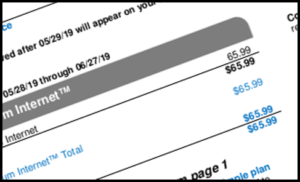 The Federal Communication Commission’s 2019 Broadband Deployment Report was finally released on May 29, after months of delay to correct serious errors in its initial data. Even with those errors partially corrected, the new report’s findings have been called “fundamentally at odds with reality” by Commissioner Starks, while Commissioner Rosenworcel has said the report “deserves a failing grade”.
The Federal Communication Commission’s 2019 Broadband Deployment Report was finally released on May 29, after months of delay to correct serious errors in its initial data. Even with those errors partially corrected, the new report’s findings have been called “fundamentally at odds with reality” by Commissioner Starks, while Commissioner Rosenworcel has said the report “deserves a failing grade”.
NDIA is forced to agree with these harsh assessments.
There are several serious problems with the report, but here’s the one we’re most concerned about: The FCC majority has chosen, once again, to ignore the critical issues of broadband cost and affordability in its analysis of “whether advanced telecommunications capability is being deployed to all Americans in a reasonable and timely fashion.”
The U.S. Census’ American Community Survey (ACS) tells us that more than 26 million American households lacked broadband Internet subscriptions of any kind – including mobile data plans — at any speed in 2017. Sixteen million of those unconnected households had annual incomes below $35,000. Sub-$35,000 households were just 31% of all U.S. households, but accounted for 60% of those without broadband.
In contrast, households making $75,000 or more constituted 38% of all U.S. households, but included just 12% (about three million) of those without home broadband connections.
Community-level data from the ACS shows large gaps in broadband access between poorer and better-off residents in big cities, small towns and rural areas alike — even in major metropolitan markets where cable and fiber broadband networks have been fully deployed for years.
(The report acknowledges this fact in passing. Figure 13 on page 31, based on the Commission’s own adoption data, shows average county broadband adoption rates increasing dramatically with median household incomes, and decreasing as county poverty rates rise. But the rest of the report is completely silent about this striking correlation.)
Clearly the cost of broadband Internet service, and households’ ability to pay that cost, are important determinants of broadband access. The physical presence of fast broadband infrastructure in a community is only valuable to the extent that community residents, institutions and businesses can afford to subscribe to it.
The evidence suggests strongly that today’s home Internet costs – with minimum monthly bills of $60, $70 or more in most markets – are blocking home broadband access for millions of lower-income households.
In our comments filed in the proceeding which led to the new Broadband Deployment Report, NDIA urged the Commission to “expand its examination of broadband adoption, as well as its metrics for progress on deployment, to include: a) developments in the cost of household broadband access, whether that cost is a barrier to access for a significant number of households, and whether that cost of access is being increased by unreasonable or anti-competitive policies and practices; and b) much greater detail regarding the rate of adoption of broadband services in different types of locality (rural, city, suburban, tribal) and by classes of consumer, particularly household income cohorts.”
Unfortunately Chairman Pai and the FCC’s majority didn’t choose to respond to NDIA’s proposals, or to address broadband cost and affordability in any other way.
For NDIA, this failure to acknowledge the very real link between broadband access and broadband affordability puts the 2019 Broadband Deployment Report, in Commissioner Starks’ words, fundamentally at odds with reality.
